While Americans have relied on a relatively stable power grid for decades, the nation now faces an unprecedented surge in electricity demand that threatens to strain its aging infrastructure. Experts project electricity demand will grow at 2.5% annually through 2035, a dramatic jump from the 0.5% growth seen over the past decade. This acceleration means the U.S. will need to add the equivalent of the UK’s total electricity consumption to its grid in just ten years.
America’s power grid faces a seismic shift as electricity demand soars at five times the historical rate.
The surge comes as 2024 set an all-time high for electricity use, with 2025 and 2026 expected to break records again. Commercial and industrial sectors lead this growth, with projected annual increases of 2.6% and 2.1% respectively through 2026. This marks a significant shift, as U.S. demand growth now exceeds the 15-year average of other advanced economies.
Several factors drive this demand boom. Data centers consume massive amounts of power as digital activities expand. Electric vehicles, now 20% of new car sales, up from 9% for full battery models, require substantial charging capacity. Heat pumps, which made up 57% of new heating installations in 2024, add to the load. Manufacturing growth and increased air conditioning use further amplify electricity needs. Geothermal energy could help meet this growing demand with its high capacity factor of 96% and around-the-clock operation regardless of weather conditions.
The grid faces serious constraints as this demand surges. Transmission buildout lags behind, creating reliability concerns. Projects face lengthy permitting and approval processes, described as fragmented and sequential. Without upgrades, the grid risks increased congestion and outages. Major grid expansion projects have been proposed specifically to enhance resilience amid rising electricity demand.
Clean energy is responding to meet demand. In 2024, solar power additions surpassed gas, though wind additions hit a decade low. Coal continues to decline, shifting pressure to renewables and flexible gas generation. The key question remains whether clean energy buildout can keep pace with demand growth.
Consumers already felt the impact in 2024, with electricity prices rising 3%. While renewable energy could help stabilize costs long-term, the immediate challenge is upgrading infrastructure fast enough to maintain reliability as America’s appetite for electricity grows at this unprecedented rate. Utility companies are struggling to meet new capacity needs with approximately 31% of transmission infrastructure already at or beyond its useful life.
References
- https://www.utilitydive.com/news/us-electricity-demand-to-grow-25-annually-thru-2035-bofa-institute/753911/
- https://www.eia.gov/todayinenergy/detail.php?id=65264
- https://ember-energy.org/latest-insights/us-electricity-2025-special-report/
- https://www.iea.org/reports/electricity-2025/executive-summary
- https://ember-energy.org/app/uploads/2025/03/US-Electricity-2025-Special-Report.pdf








